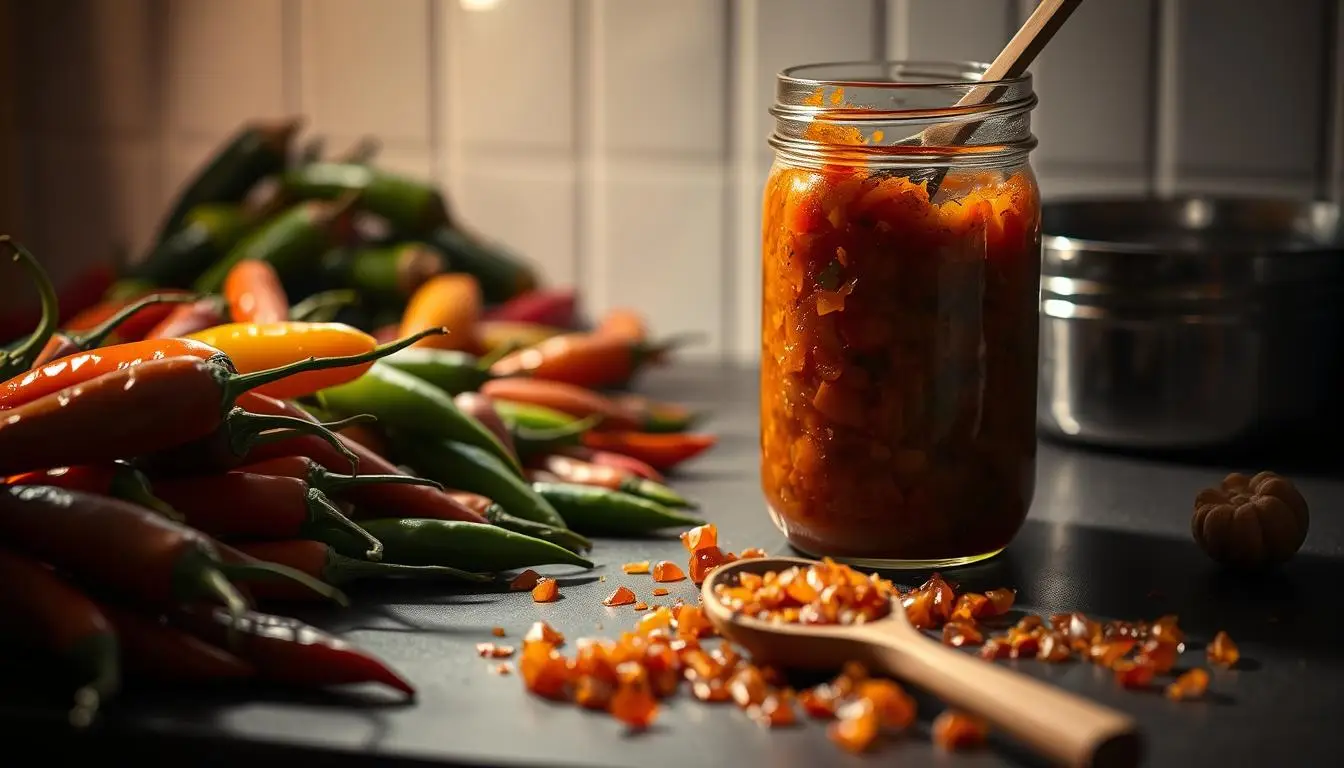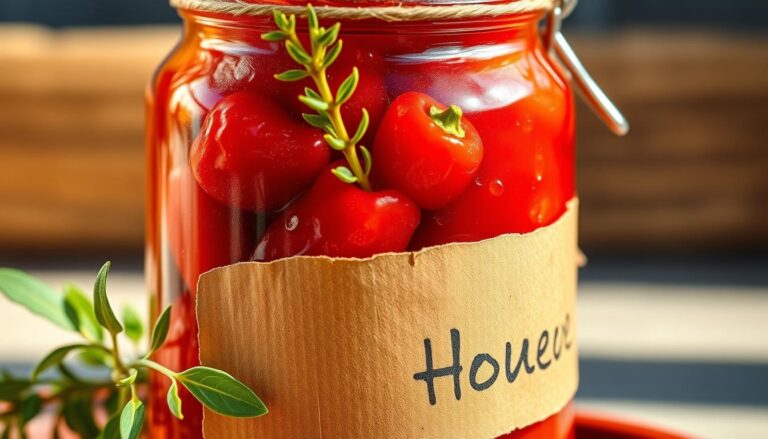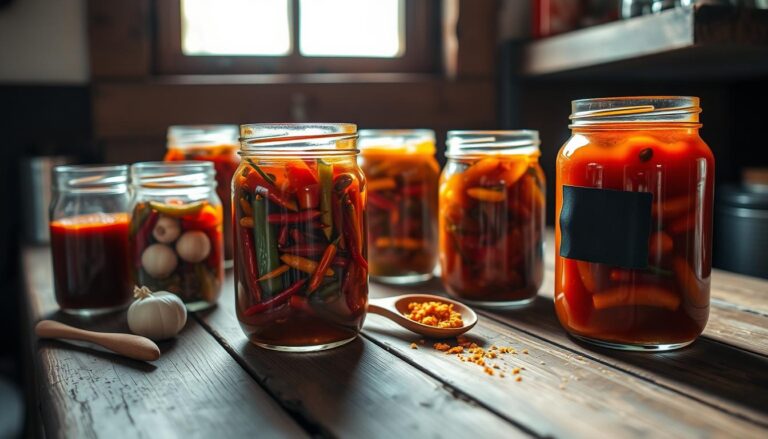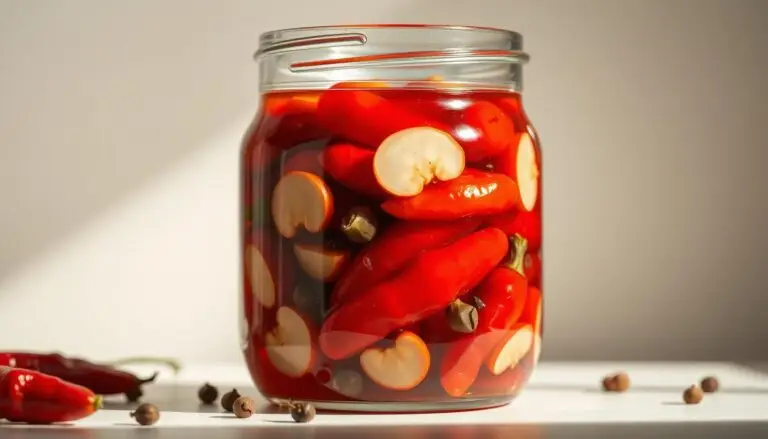Fermented Pepper Mash: How to Prepare and Use for Hot Sauce Recipes
Hot sauce lovers have found a new way to make amazing homemade pepper mash. This method turns simple peppers into complex, probiotic-rich sauces. These sauces can make any dish better.
Starting your homemade pepper mash journey is easy. Just use 30-40 habanero peppers and 2 orange bell peppers. You’ll get a mash full of flavor, just like store-bought hot sauces.
The secret to great fermented pepper mash is simple. Use 2% salt by weight and let nature do the rest. This way, you get a sauce that’s not just tasty but also good for you.
Whether you love trying new foods or collecting hot sauces, making fermented pepper mash is a must. You can make everything from Louisiana-style to Sriracha-inspired sauces. Your homemade mash will wow everyone you share it with.
Understanding the Art of Fermented Pepper Mash
Pepper mash fermentation turns regular peppers into a rich, flavorful ingredient. This old method brings out peppers’ unique traits, making them nutritious and tasty.
The science behind pepper mash fermentation is amazing. When peppers ferment, good bacteria break down sugars, making lactic acid. This not only keeps the peppers fresh but also adds incredible flavor.
The Scientific Process of Fermentation
Several important changes happen during fermentation:
- Leuconostoc mesenteroides bacteria start working in the first 1-3 days
- Lactobacillus plantarum takes over between days 4-10
- pH levels fall from about 6.5 to 3.4-3.8
Benefits of Fermenting Peppers
Fermented pepper mash offers many benefits. It’s not just about keeping peppers fresh. You’ll find amazing advantages:
- Enhanced Flavor Profile: Fermentation adds complex, tangy flavors
- Increased Nutritional Value
- Probiotic Development
- Extended Shelf Life
Why Create Your Own Pepper Mash
Creating your own fermented pepper mash lets you control the ingredients and taste. With basic tools and patience, you can make a unique condiment that’s as good as store-bought hot sauces.
Fermentation is a culinary art that transforms simple ingredients into extraordinary flavors.
The best fermentation temperature is between 68-72°F. It takes weeks. Your homemade pepper mash can last a year in the fridge, giving you a steady supply of tasty, probiotic-rich sauce.
Essential Equipment and Tools for Making Pepper Mash
To make fermented pepper mash, you need the right tools. These tools help you succeed and stay safe. Start by getting the necessary equipment for your home fermentation journey.
Here are the essential tools you’ll need for creating fermented pepper mash:
- Digital kitchen scale for precise ingredient measurements
- Food processor or sharp chef’s knife for chopping peppers
- Wide-mouth mason jars for fermentation
- Digital pH meter for safety monitoring
- Fermentation weights to keep peppers submerged
- Airlocks for gas release during fermentation
You don’t have to spend a lot to get started. Many people use what they already have in their kitchens. Getting a few special tools can really boost your pepper mash quality.
| Tool | Purpose | Estimated Cost |
|---|---|---|
| Digital Kitchen Scale | Precise ingredient weighing | $20-$40 |
| pH Meter | Safety monitoring | $30-$80 |
| Mason Jars | Fermentation vessel | $10-$20 per set |
| Fermentation Weights | Keep peppers submerged | $10-$15 |
Remember, the right tools are key to a successful ferment. Take time to learn how each tool helps in the fermentation process.
Selecting the Right Peppers and Ingredients
Creating the perfect spicy pepper mash starts with understanding your pepper options and ingredients. Your fermented hot pepper mash will be unique based on the peppers and additional components you choose.
Best Pepper Varieties for Fermentation
When preparing fermenting hot pepper mash, your pepper selection dramatically impacts flavor and heat. Different peppers offer unique characteristics:
- Mild Peppers (0-500 SHU): Bell peppers, banana peppers
- Medium Heat (2,500-25,000 SHU): Jalapeños, serranos, fresno peppers
- Hot Peppers (30,000-100,000 SHU): Cayenne, Thai chilies
- Super Hot (100,000-500,000 SHU): Habaneros, Scotch Bonnet
Salt Types and Ratios
Salt plays a key role in your spicy pepper mash fermentation. Use non-iodized salt for best results. The ideal salt concentration ranges between 2-3% by total weight of the pepper mash.
Additional Flavor Enhancers
Elevate your fermenting hot pepper mash by incorporating complementary ingredients:
- Garlic cloves
- Onions
- Fresh herbs
- Fruits like mangoes or pineapples
Each ingredient will transform your pepper mash, creating a unique and complex flavor profile that suits your personal taste preferences.
Step-by-Step Guide to Fermented Pepper Mash
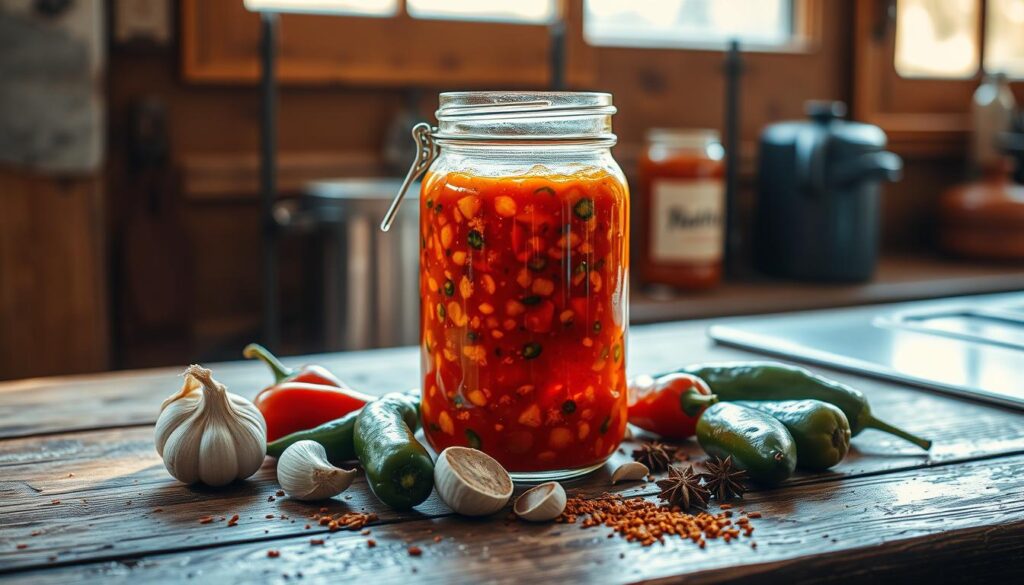
Learning to make fermented pepper mash is a fun journey. It turns simple peppers into a tasty condiment. Don’t worry, it’s easier than you think to make delicious fermented pepper mash at home.
First, get your ingredients and tools ready. You’ll need:
- Fresh peppers
- Non-iodized salt
- Clean glass jars
- Kitchen scale
- Fermentation weights
Start by washing your peppers well. Wear gloves when handling hot peppers to avoid skin irritation. Take off the stems and choose whether to keep or remove the seeds, depending on how spicy you like it.
To make your own fermented pepper mash, follow these steps:
- Chop peppers into small, uniform pieces
- Weigh your peppers and calculate the right salt amount (usually 3% of total weight)
- Blend peppers with salt to make a smooth mash
- Pack the mash into clean jars
- Make sure peppers are fully covered by brine
Keep the fermentation area at 65°F to 75°F. You’ll see signs of fermentation in 3-4 days, like bubbling and a tangy smell. It usually takes 2-4 weeks to ferment, depending on how you like it.
Pro tip: Taste your pepper mash weekly to track its flavor development and determine when it reaches your desired taste profile.
By following these steps, you’ll make a rich, complex fermented pepper mash. It’s great for hot sauces, marinades, and condiments.
Salt Ratios and pH Levels: Getting the Science Right
When making hot sauce from fermented peppers, knowing the science is key. The process needs precise measurements and constant checks. This ensures the sauce tastes great and is safe to eat.
Calculating Salt Percentages
Salt is very important in making hot sauce from fermented peppers. The best salt amount is 2% to 3% of the total ingredients. This helps good bacteria grow while keeping bad ones away.
- Use a digital scale for accurate measurements
- Calculate salt based on total pepper weight
- Aim for 20-30 grams of salt per kilogram of peppers
Monitoring pH for Safety
Keeping an eye on pH levels is vital when fermenting peppers. A pH below 4.6 is safe, stopping dangerous bacteria like Clostridium botulinum from growing.
| pH Level | Safety Status | Recommended Action |
|---|---|---|
| Below 4.0 | Optimal Safety | Continue fermentation |
| 4.0 – 4.6 | Acceptable | Monitor closely |
| Above 4.6 | Unsafe | Discard batch |
Signs of Successful Fermentation
A good pepper mash for hot sauce will show clear signs of fermentation. Look for these signs:
- Consistent bubble formation
- Pleasant sour smell
- Color transformation
- Slight softening of peppers
The fermentation time is usually two to six weeks. It depends on your recipe and the environment. Being patient and watching closely is important for a great hot sauce.
Common Fermentation Issues and Troubleshooting
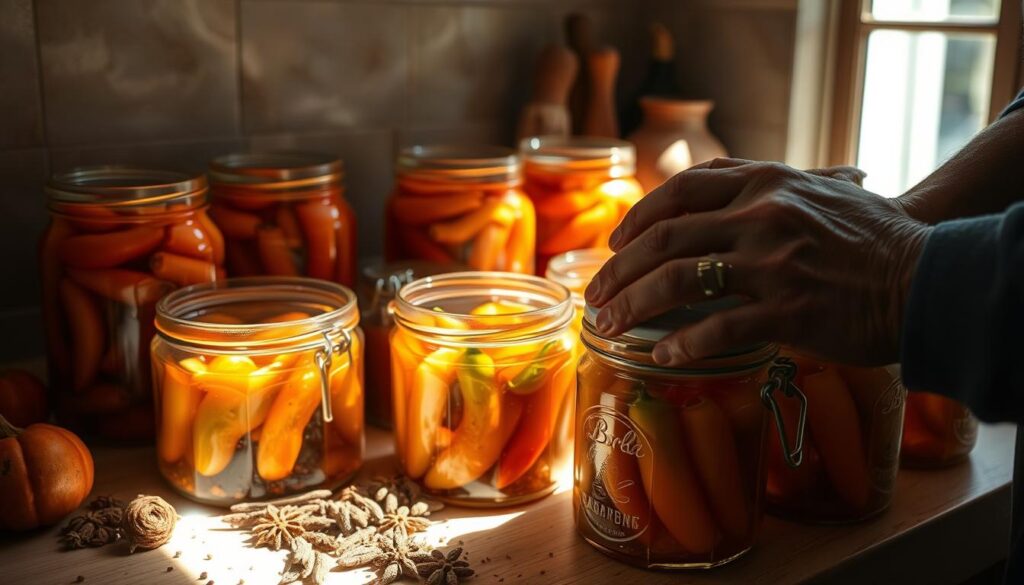
Fermenting peppers at home can come with its own set of challenges. Knowing these issues can help you overcome them and make great hot sauce.
Mold growth is a big problem to watch out for. White, green, or black fuzzy patches mean your batch is contaminated. To avoid this, always use clean tools and keep the right salt ratio.
- Key Warning Signs of Fermentation Problems:
- Unusual color changes
- Slimy texture
- Offensive odors
- Visible mold growth
Temperature is also very important for fermentation. The best temperature is between 60-75°F. If it’s too hot or cold, fermentation can slow down or stop.
| Issue | Possible Cause | Solution |
|---|---|---|
| No Fermentation Activity | Low Temperature | Move to warmer location |
| Mold Development | Improper Salt Ratio | Adjust salt concentration |
| Off-Odors | Contaminated Equipment | Sanitize all tools |
To ferment peppers well at home, keep things clean, use the right salt, and check your mash often. With time, you’ll get better at handling fermentation.
Creating Hot Sauce from Your Fermented Pepper Mash
Now that your homemade pepper mash has fermented, it’s time to make a delicious hot sauce. This sauce will have intense flavors and health benefits. You’ll need to blend, season, and preserve it carefully.
Basic Hot Sauce Recipe
Making your own hot sauce is easy. Here’s a simple recipe to start with:
- 2 cups fermented pepper mash
- 1 tablespoon rice vinegar
- 2 teaspoons lime juice
- Salt to taste
Flavor Variations and Additions
Try new things with your homemade pepper mash. Add unique ingredients to make your own hot sauce:
- Fruity Twist: Blend in mango or pineapple
- Smoky Flavor: Add roasted garlic or chipotle
- Herbal Notes: Mix in fresh cilantro or basil
Straining and Bottling Techniques
Straining is key for a smooth hot sauce. Use a fine-mesh strainer or cheesecloth to get rid of solids. This will make your sauce silky.
| Bottling Parameter | Recommendation |
|---|---|
| Storage Container | Glass bottles with tight seals |
| Refrigeration | Up to 90 days |
| Salt Concentration | 3-4% of pepper weight |
Your homemade fermented pepper mash hot sauce is now ready. It will add rich, complex flavors to your dishes!
Storage and Shelf Life of Fermented Pepper Products
Creating fermented hot pepper mash? Knowing how to store it is key. Your homemade hot sauce can last up to a year in the fridge.
Several factors help your mash last longer:
- Maintaining a low pH level (below 4.6)
- Using clean, sterilized storage containers
- Keeping the product refrigerated
- Monitoring for any signs of spoilage
Refrigeration slows down bacteria, keeping your mash’s flavors bright. Marie Sharp’s experts say to store fermented products in cool, consistent temperatures.
Watch out for these signs of spoilage:
- Unusual mold growth
- Off-putting smell
- Significant color changes
- Unusual texture or separation
For the best storage, put your mash in airtight glass containers. Dark glass protects from light. Seal well and keep it in the fridge’s coldest spot for longer life.
Pro tip: Always use clean utensils when removing sauce from the container to prevent contamination.
Follow these tips to keep your fermented hot pepper mash tasty and safe for months.
Experimenting with Different Pepper Varieties and Flavors
Making fermented pepper mash is a fun way to try out different tastes and heat levels. Each type of pepper adds its own special touch to your hot sauce. This can really change how you enjoy food.
When you start making spicy pepper mash, think about the heat levels of different peppers:
- Mild Peppers (0-500 SHU): Bell peppers, Banana peppers
- Medium Peppers (2,500-25,000 SHU): Jalapeños, Serranos, Fresno
- Hot Peppers (30,000-100,000 SHU): Cayenne, Thai chilies
- Super Hot Peppers (100,000-500,000 SHU): Habaneros, Scotch Bonnet
- Extremely Hot Peppers (500,000+ SHU): Ghost peppers, Carolina Reapers
To make your fermented pepper mash even better, try adding things like garlic, fruits, or herbs. These can mix with the pepper flavors to make your hot sauce even more interesting.
| Pepper Type | Heat Level (SHU) | Flavor Profile |
|---|---|---|
| Jalapeño | 6,000 | Grassy, bright |
| Habanero | 250,000 | Fruity, intense heat |
| Thai Bird’s Eye | 80,000 | Sharp, intense |
Keep your fermentation area at 68-72°F (20-22°C). Also, check the pH levels to make sure your spicy pepper mash turns out right.
Safety Considerations and Best Practices
When you’re making hot sauce from fermented peppers, safety is a top priority. Knowing the basics of fermentation is key to making tasty and safe pepper mash at home.
To ferment pepper mash safely, focus on a few important things:
- Keep the pH levels between 3.4-3.8
- Use clean, sterilized tools
- Watch the temperature (68-72°F)
- Check the salt level (2-3% by weight)
Keeping bacteria in check is vital during fermentation. The early stages involve certain bacteria that add flavor and safety. Leuconostoc mesenteroides starts, then Lactobacillus plantarum keeps things stable.
“Prevention is better than cure when it comes to fermented hot sauce preparation.”
Look out for these signs that your ferment might be off:
- Unusual colors or fuzzy mold
- Rancid or bad smell
- Big pH level changes
- Slime or weird texture
Right salt levels are key to a safe ferment. A 50% salt cap stops bad microbes from growing when you’re fermenting peppers for hot sauce.
Fermentation is both a science and an art. By sticking to these safety tips, you’ll make tasty, safe, and delicious homemade hot sauces. They’ll show off your cooking talent.
Conclusion: Mastering the Art of Fermented Pepper Mash
Fermenting peppers at home is a fun journey that turns simple ingredients into amazing hot sauces. The benefits of fermented pepper mash go beyond just taste. You get complex flavors and health perks that store-bought sauces can’t offer.
Creating fermented pepper mash needs patience, care, and a spirit of adventure. With just Tabasco peppers, kosher salt, and white vinegar, you can make a sauce that’s all your own. The 1-2 week wait lets natural bacteria create deep, tangy flavors that make any meal better.
When fermenting peppers, safety and skill are key. Keep a close eye on your mash, use the right salt amounts, and store it in clean glass bottles. Your homemade hot sauce will last up to 3 months in the fridge, perfect for sharing with loved ones.
Begin your fermentation journey now and explore the rich world of homemade hot sauces. Your taste buds will love the journey of discovering this ancient preservation method.
Top Chef Tools Recommended for Making Fermented Pepper Mash:
- Digital kitchen scale
- Food processor
- sharp chef’s knife
- Wide-mouth mason jars
- Digital pH meter
- Fermentation weights
- Airlocks
Check This For More Homemade Pepper Mash Recipes

